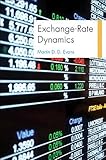Exchange-Rate Dynamics / Martin D. D. Evans.
Material type: TextSeries: Princeton Series in International EconomicsPublisher: Princeton, NJ : Princeton University Press, [2011]Copyright date: ©2011Description: 1 online resource (600 p.) : 46 line illus. 34 tablesContent type:
TextSeries: Princeton Series in International EconomicsPublisher: Princeton, NJ : Princeton University Press, [2011]Copyright date: ©2011Description: 1 online resource (600 p.) : 46 line illus. 34 tablesContent type: - 9781400838844
- Foreign exchange market
- Foreign exchange rates
- Money -- Tables
- BUSINESS & ECONOMICS / Econometrics
- Aggregate demand
- Algorithmic trading
- Approximation
- Arbitrage
- Ask price
- Asset
- Autocorrelation
- Balance of trade
- Basis Point
- Bid price
- Brokerage firm
- Budget constraint
- Calculation
- Central bank
- Coefficient
- Conditional expectation
- Consumption (economics)
- Covariance matrix
- Currency pair
- Currency
- Customer
- Day trading
- Depreciation
- Determinant
- Determination
- Discounts and allowances
- Dividend
- Dollar Price
- Economic equilibrium
- Economics
- Economy
- Elasticity of substitution
- Estimation
- Exchange rate
- Expected value
- Financial asset
- Forecast error
- Forecasting
- Foreign exchange market
- General equilibrium theory
- Government bond
- Hedge fund
- Household
- Impulse response
- Income
- Inference
- Inflation
- Interest rate parity
- Interest rate
- Interest
- International economics
- Investment
- Investor
- Kalman filter
- Limit price
- Long run and short run
- Macroeconomics
- Marginal utility
- Market clearing
- Market liquidity
- Market participant
- Monetary policy
- Money market
- Money supply
- Nominal interest rate
- Output gap
- Prediction
- Present value
- Price Change
- Price fixing
- Price index
- Price level
- Pricing
- Probability
- Production function
- Purchase order
- Purchasing power parity
- Rate base (utility)
- Rate of return
- Rational expectations
- Real interest rate
- Real versus nominal value (economics)
- Risk aversion
- Risk premium
- Spot contract
- Spot market
- Standard deviation
- Standard error
- Statistic
- Statistical significance
- Stochastic discount factor
- Supply (economics)
- Taylor rule
- Time series
- Trader (finance)
- Trading strategy
- Value (economics)
- Variance
- Wealth
- World economy
- 332.4/56 22
- HG3851 .E77 2011eb
- online - DeGruyter
| Item type | Current library | Call number | URL | Status | Notes | Barcode | |
|---|---|---|---|---|---|---|---|
 eBook
eBook
|
Biblioteca "Angelicum" Pont. Univ. S.Tommaso d'Aquino Nuvola online | online - DeGruyter (Browse shelf(Opens below)) | Online access | Not for loan (Accesso limitato) | Accesso per gli utenti autorizzati / Access for authorized users | (dgr)9781400838844 |
Frontmatter -- Contents -- Preface -- PART I MACRO MODELS -- Chapter 1 Macro Models without Frictions -- Chapter 2 Macro Models with Frictions -- Chapter 3 Empirical Macro Models -- PART II MICROSTRUCTURE MODELS -- Chapter 4 Rational Expectations Models -- Chapter 5 Sequential Trade Models -- Chapter 6 Currency-Trading Models -- Chapter 7 Currency-Trading Models: Empirical Evidence -- Chapter 8 Identifying Order Flow -- PART III MICRO-BASED MODELS -- Chapter 9 Order Flows and the Macroeconomy -- Chapter 10 Exchange Rates, Order Flows, and Macro Data -- Chapter 11 Exchange-Rate Risk -- References -- Index
restricted access online access with authorization star
http://purl.org/coar/access_right/c_16ec
A comprehensive and in-depth look at exchange-rate dynamicsVariations in the foreign exchange market influence all aspects of the world economy, and understanding these dynamics is one of the great challenges of international economics. This book provides a new, comprehensive, and in-depth examination of the standard theories and latest research in exchange-rate economics. Covering a vast swath of theoretical and empirical work, the book explores established theories of exchange-rate determination using macroeconomic fundamentals, and presents unique microbased approaches that combine the insights of microstructure models with the macroeconomic forces driving currency trading.Macroeconomic models have long assumed that agents—households, firms, financial institutions, and central banks—all have the same information about the structure of the economy and therefore hold the same expectations and uncertainties regarding foreign currency returns. Microbased models, however, look at how heterogeneous information influences the trading decisions of agents and becomes embedded in exchange rates. Replicating key features of actual currency markets, these microbased models generate a rich array of empirical predictions concerning trading patterns and exchange-rate dynamics that are strongly supported by data. The models also show how changing macroeconomic conditions exert an influence on short-term exchange-rate dynamics via their impact on currency trading.Designed for graduate courses in international macroeconomics, international finance, and finance, and as a go-to reference for researchers in international economics, Exchange-Rate Dynamics guides readers through a range of literature on exchange-rate determination, offering fresh insights for further reading and research.Comprehensive and in-depth examination of the latest research in exchange-rate economicsOutlines theoretical and empirical research across the spectrum of modeling approachesPresents new results on the importance of currency trading in exchange-rate determinationProvides new perspectives on long-standing puzzles in exchange-rate economicsEnd-of-chapter questions cement key ideas
Mode of access: Internet via World Wide Web.
In English.
Description based on online resource; title from PDF title page (publisher's Web site, viewed 01. Dez 2022)


